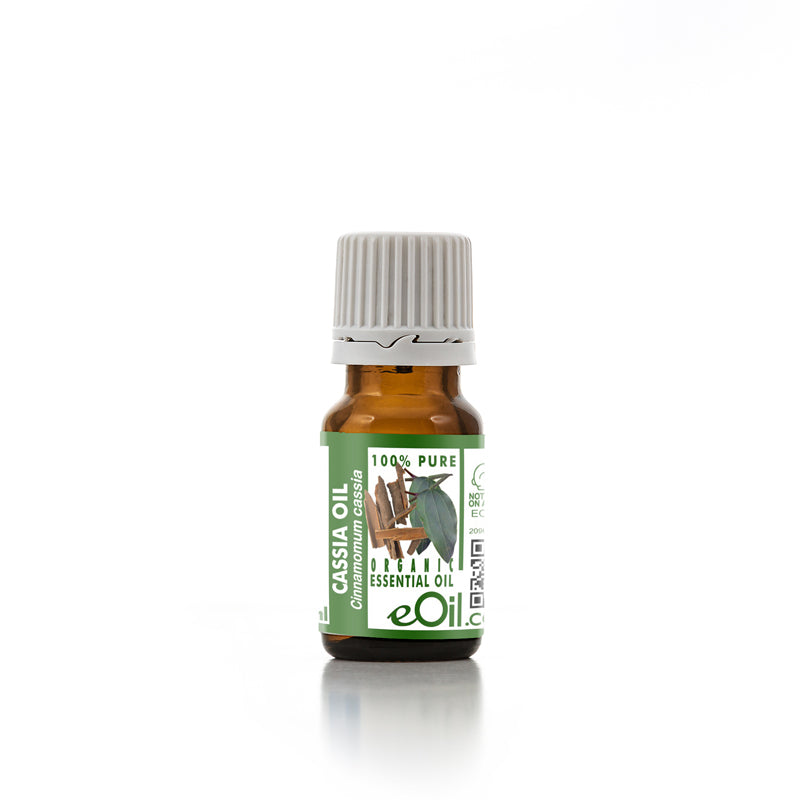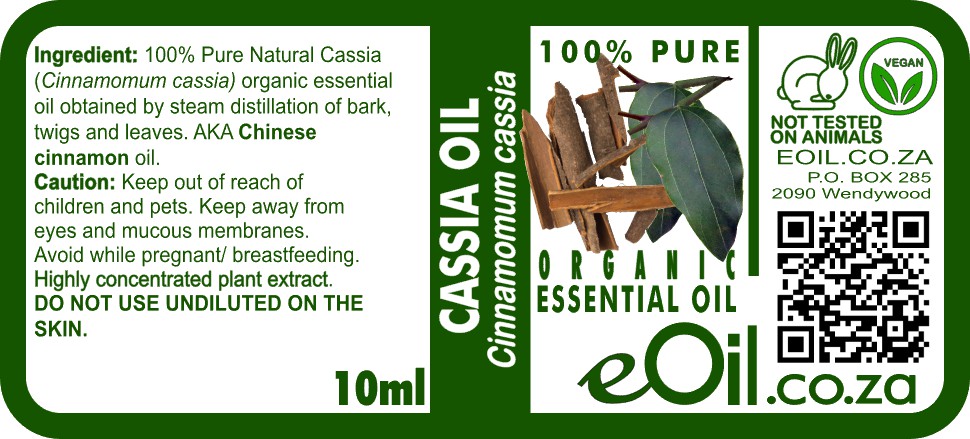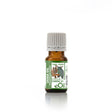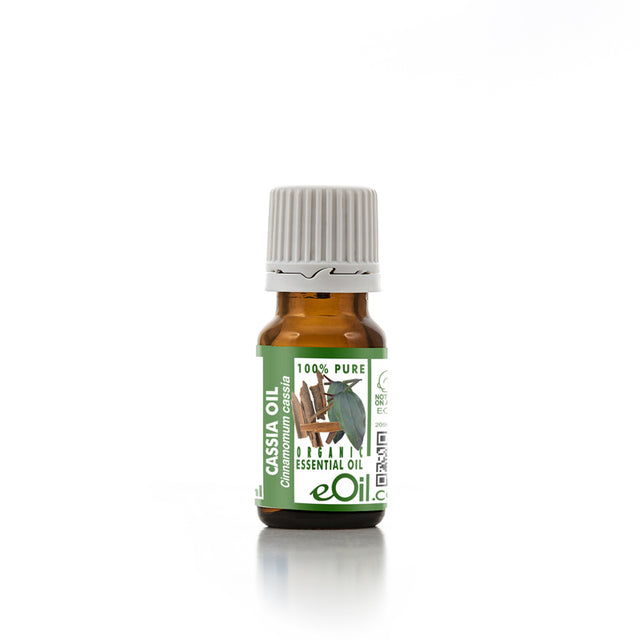Cassia Essential Oil Organic
Cassia Essential Oil Organic - 10 ML is backordered and will ship as soon as it is back in stock.
Description
Description
Cassia Essential Oil Organic (Cinnamomum cassia) delivers a bold, spicy-sweet aroma reminiscent of cinnamon.
Steam distilled from bark, branches, and leaves, it is valued in aromatherapy for its warming and comforting qualities.
100% pure, natural, and certified organic—perfect for mindful blends and a cozy atmosphere
INFORMATION
INCI Name : Cinnamomum cassia (Cassia) oil
SYNONYM : Cinnamomum aromatica
CAS Number : 8007-80-5, 84961-46-6
SKU code :
EXTRACTION METHOD: Steam distillation
PARTS USED: Bark, Branches/Twigs, and Leaves.
ORIGIN: Vietnam
COMMON NAMES: Chinese cassia oil, Chinese cinnamon oil.
APPEARANCE: Pale yellow to orange-brown fluid essential oil.
ODOUR NOTE: Strong top note to middle-base note. Fixative and enhancer of woody and sweet notes. Highly aromatic, bold warm and spicy, typical of cinnamon aroma, but noticeably sweeter.
QUALITY: 100 % pure and whole essential oil. From organic cultivation (Agro forestry)
TYPICAL MOLECULAR COMPONENTS: 85.41% E-Cinnamaldehyde (74 to 88%), 1.39% Coumarins
STORAGE CONDITION: Keep bottles tightly closed, in a cool, dry place protected from sunlight and heat sources. Store away from children and pets’ reach.
INFOS AND INTERESTING FACTS
Used throughout history and mentioned in religious scriptures Cassia oil is part of the “sacred” oils, often blended in olive oil with Myrrh, Calamus, and Frankincense to create anointing oils used in spiritual rituals across cultures.
Compared to Cinnamon Bark essential oil, Cassia has sweet (honeyed) undertone that immediately brings to mind cinnamon gums, buns and other typical mouthwatering confectioneries and patisseries.
Used in natural perfumery to bring spicy warmth, power, and sweetness to floral and oriental types of blends, Cassia essential oil share the same energizing and highly purifying properties with Cinnamon bark and the same cautions when used for skin applications (high in cinnamaldehyde).
In Aromatherapy Cassia oil and Cinnamon bark are interchangeable. In natural perfumery and for all rituals orientated blends, the preferred aroma is often Cassia oil.
INSTRUCTIONS OF USE
Like all essential oils from the Cinnamon family, this pure Cassia oil must be heavily diluted in an appropriate carriers/base before any skin applications (may cause skin irritations if used pure).
Please perform a skin patch test by applying a drop of PRE-DILUTED Cassia oil (Add 1 drop of cassia oil in a tablespoon of carrier oil- Dip the tip of an earbud in that dilution and dab lightly on your forearm in the evening.
Check for any immediate reactions, and again in the morning- Discontinue skin applications, if severe reactions occur or try diluting even more= more carrier oil per 1 drop).
When used by itself (as in “not blended with other essential oils”, but still DILUTED in a carrier oil prior to applications), this powerful essential oil is best reserved for adults, on very targeted areas (a spot) of applications (avoiding eyes and all mucous membranes) and for short periods of time only.
Bottom line: USE with parsimony. Do not apply near or on sensitive areas (Eyes, nose, Face, mucous membranes…).
Use in blends/ synergies with other softer essential oils and always dilute in a carrier before skin application.
Targeted and spot applications:
Occasional body applications, on localized areas and for limited periods of time:
Targeted spot treatment (Acne, warts, athlete foot): Use 1drop Cassia essential oil per 1teaspoon/100 drops of carrier oil (0.05% concentration to1% maximum); well diluted and preferably with other essential oils (lavender…), in carrier oils. use in warm compresses for muscle aches.
Body massages, Scalp care use, beard grooming serum:
applied in friction on more extended areas:
2 drops Cassia essential oil in a synergy with other essential oils, per 30 ml carrier or base (0.05 % concentration up to 5%).
Dilute in carrier oil for warming and circulation, soothing or boosting massages; Add to body oils or lotions for skin-toning effects; blended in a carrier oil for beard grooming.
Add to hair masks or conditioners for strengthening and shine.
Oral care: in mouth washes and mouth oils: use cautiously (lips and gums!)
Diffusion
- Ultrasonic Diffusers for ambiance, meditations, rituals: blend (between 5 to 10% ratio) with other essential oils or absolutes, diffuse for 10 min 3 times a day. Do not diffuse alone (as in not just cassia oil)
- Olfactory (from tissue) and Stick inhalation (DRY inhalations) are authorized when blended with other essential oils. ATTENTION: DO NOT USE for WET/ STEAM/ HUMID INHALATIONS (see cautions)
- Room Sprays: Create room sprays for a festive, warm, meditative, or gourmet ambiance.
Cassia as an ancient spice and its essential oil are considered as “sacred” in some spiritual traditions, often associated with Frankincense, Myrrh, Rock Rose, Sandalwood, Palo Santo…. Cassia essential oil in this context is diffused for religious rituals, to create a meditative/prayer atmosphere or anointed in oils/balms:
- As a sign of purification, cleansing of spirit, mind, and body.
- To help with focus, help connect with inner spirituality and with the Divine
- To strengthen inner-resolve and positive self-esteem
Others
- Cooking: 1 drop added cold the buttery or syrupy phase of your preparations, brings a powerful and mouth-watering aroma to your dishes. Great in fruits salads, marmalades, patisseries but also in your sweet and sour, curry sauces. Use with parsimony.
- Homecare: in insect repellent or cleansing spray (with vinegar for kitchen tops cleansing…)
In Natural perfumery: from 0.04% up to 3.5% in a perfume compound. Note that IFRA restrict the dosage of Cassia essential oil in fragranced products for skin uses (stay on) to a maximum of 0.05%.
Uses:
- As an accent touch in spicy-oriental compositions.
- In Christmas evocative warm sweet and spicy blends
- In sensual massage oils blends.
For more detailed information, please go check this LINK TO Instructions of use essential oils page
DO NOT USE UNDILUTED ON THE SKIN and SEEK MEDICAL AND SPECIALIST ADVISE WHEN IN DOUBT.
SEE OUR PAGE ON PRECAUTION - HOW TO USE ESSENTIAL OILS SAFELY
REPORTED BENEFITS & PROPERTIES
- Antimicrobial and Antiseptic: Inhibits the growth of microorganisms, making it a natural disinfectant.
- Digestive Aid: Helps relieve digestive discomfort and stimulates the secretion of digestive enzymes.
- Mood Enhancer: Uplifts mood and alleviates symptoms of depression and anxiety.
- Respiratory Support: Provides relief from coughs, colds, and congestion.
- Natural Insect Repellent: Acts as a deterrent for mosquitoes and other insects.
- Pain Reliever: Alleviates pain and reduces inflammation when used topically.
- Wide spectrum antibacterial and anti-septic +++
- Wide spectrum anti-fungal, anti-fermentation +++
- Anti-parasitic/ insecticidal+++
- General stimulant, Immune system boosting, warming, +++
- General Tonic, stimulant, aphrodisiac, Uterus/ovarian tonic
- General respiratory and nervous system tonic
- Anti-inflammatory
- Antiviral
- Antioxidant
- Circulatory (increase local blood flow)
- Anti-coagulant, fluidifying, Emmenagogue (increase menstrual flow)
TRADITIONALLY USED
- In Ayurveda, associated to the 1rst chakra (root), grounding, balancing.
- In ceremonial, rituals sacred balms and anointing oils.
- In meditation blends, in incense and votive candles creations.
- A staple in traditional Chinese medicine (Chinese pharmacopoeia): for its very potent and large spectrum antibacterial properties (applied to various gastro- intestinal, urinary tract, gynaecological, fungal conditions)
- In stimulating blends: physical and mental boost (fatigue, burn-outs, low energy…)
- In tropical diseases blends (intestinal infections, parasites, dysentery …when associated with fevers)
- And gastro-digestive support synergies, including bloating or sluggish digestion, applied in massages on lower back and lower abdomen.
- In dental/ oral discomfort blends (abscess, gingivitis…)
- In synergies (Massages lower back and lower abdomen), in support of lower abdomen infections linked to urinary tract or gynaecology (cystitis, menopause, and PMS symptoms).
- In synergies formulations for Warts (targeted applications)
- In synergies formulations for feet fungi, recurring/ resistant mycosis (targeted applications)
- In stick inhalers synergies to help control hunger
- In stick inhalers synergies and traditional warming balms for colds and flu supports
- In Professional fragrant ambiance, gourmand blend creations, for bakeries and patisseries (often associated with orange, clove, and vanilla).
In aromatherapy blends:
In massages oils as powerful large spectrum anti-bacterial and anti-fungal, Natural defence,
in digestive and intestinal healthy gastro-digestive synergies.
In extremities warming, warming and circulatory massage oils; urinary tract, PMS support;
In winter frictions blends, support in times of cold (flu, bronchitis); As a nervous system tonic, general stimulant (fatigues, low moods), aphrodisiac;
For targeted applications in acne, warts and mycoses;
For rituals and ceremonials blends: Anointing oils blends, Festive seasons blends; Christmas scent.
In natural perfumery for oriental or spicy creations and as a fixative mood lifting, meditation blends. Strong, Sweet-warm, highly aromatic.
WELLBEING MASSAGES, BODY CARE.
Always heavily diluted and in little quantities in:
- Body massages;
- Targeted Body care (no cosmetics);
- Scalp care and Beard grooming preparations;
- Compresses;
- Oral care (in mouth washes, oral waters).
DIFFUSION
Never by itself (Blended with other essential oils), in small quantities.
- Ultrasonic diffusion & dry olfaction only.
- Purifying Home Sprays
OTHERS
- Anointing rituals
- Cooking
- Homecare
- Perfumery
EXAMPLES OF RECIPES
Christmas spirit festive Blend for diffuser
- 2 drops cassia essential oil
- 3drops Orange (sweet) essential oil
- 2 drops Balsam fir essential oil
- 1 drop Clove essential oil
Renewed spirit (Easter time) synergy for diffuser
- 1 drop Cassia essential oil
- 3 drops Bergamot essential oil
- 2 drops Myrrh essential oil
- 2 drops Sandalwood essential oil.
Sacred oil (Anointing oil)
To 5 ml (1 teaspoon) of Extra virgin oil add:
- 1 drop cassia essential oil
- 1 drop Myrrh essential oil
- 1 drop Frankincense (Indian) essential oil
Diffusion for Spiritual/ meditation atmosphere
- 1 drops cassia essential oil
- 2 drop Sandalwood essential oil
- 2 drops Frankincense sacra essential oil
- 1drop Vetiver essential oil
Synergy in support of Gastro-Digestive discomforts-massage oil
In a 20 ml amber bottle with dropper and cap add:
- 20 drop cassia essential oil
- 20drops cardamom essential oil
- 20 drops tarragon essential oil
- 20 drops peppermint essential oil
- 20 drops tea tree essential oil
Top up with Macadamia or any other carrier oil of your choice. Close tightly with dropper and cap. Shake to blend. Label.
Apply 4-6 drops of your “tummy aches” synergy onto the abdomen and lower back.
Spiced Oriental Perfume Oil (10ml roller)
- 1 drop Cassia
- 2 drops Rose Geranium
- 3 drops Bergamot
- 1 drop Labdanum
Top up with Jojoba oil/ Sandal wood nut oil…
Apply to pulse points as a warm winter fragrance oil.
Immune-Boosting Room Spray (100ml)
- 10 drops Cassia
- 15 drops Lemon
- 5 drops Eucalyptus.
- 10ml perfumers’ base (home fragrance)
- Top up with water or a hydrosol of your choice.
Mist 3x daily during flu season.
Ayurvedic Joint Relief Oil (100ml)
- 5 drops Cassia.
- 10 drops Ginger
Top up with Sesame oil.
Massage a few drops to stiff joints morning/evening.
Synergy for Warts,
Applied with a cotton bud on the area, precisely.
In an empty 10 ml amber bottle, mix:
- 10 drops cassia essential oil
- 10 drops mountain savoury (winter) essential oil
- 40 drops tea tree essential oil
40 drops lemon essential oil
Top up with a carrier oil of your choice. Close tightly with dropper and cap. Label.
When ready to use, apply a few drops to soak the cotton bud tip and dab lightly on warts.
Use 2 to 3 times a day, on a clean, dry skin.
Seasonal wellness:
Diffuse 2 drops Cassia + 3 drops Sweet Orange to combat winter lethargy.
Aphrodite sensual massage oil
In a 100ml amber bottle with a serum pump, combine:
4 drops Cassia oil, 40 drops Rosewood essential oil, 20 drops Ylang-Ylang essential oil and top up with a neutral carrier oil (Jojoba, Hazelnut…) or a naturally aromatic oil (Green tea, Vanilla bourbon macerated…)
Massage a few drops of your warming oil, to the lower back, to help stimulate or re-awaken sensuality, 2x/day for 2 weeks.
Boost the mood and Energizing Massage oil (100ml)
- 17 drops Cassia oil
- 17 drops Ginger oil
- 33 drops Bay laurel
15 drops lemon oil
Top up with jojoba/ hazelnut/ Macadamia oil.
Appetite control support
In inhaler sticks or tissue olfaction:
First combine the following in an empty (recycled?)10 ml amber bottle with dropper.
- 90 drops lemon essential oil
- 90 drops cassia oil
- 90 drops petit grain essential oil
Insert dropper and close tightly with a cap. Label your bottle.
When ready to make your inhaler stick, apply a few drops onto a new cotton stick, until well soaked. Insert in the tube and close. Apply a label to your inhaler.
Alternatively, add 2 drops on a tissue and inhale a few times, taking care not to touch your skin.
Use to help manage snack cravings whenever needed.
Meditation blend:
Diffuse1 drop Cassia + 2 drops Frankincense for grounding during meditation.
Homecare:
Add 2 drops of cassia to 100ml white vinegar solution for a natural antimicrobial surface cleaning
BLENDS WELL WITH
- Other sacred essential oils: Frankincense, Myrrh, Sandalwood, Rock rose or Labdanum, Spikenard, Patchouli, Rose
- Oregano, clove, Savory, bay leaf, tea tree or Niaouli, Ravintsara for purifying applications, skin parasites and warts;
- Arnica oil, Shea butter and beeswax combined with peppermint, tea tree, eucalyptus, and wintergreen essential oils to create warming friction balms.
- With berry, fruity essential oils and absolute, Cassis, Davana… to évoque Christmas, the orients
- Vanilla absolute and Benzoin for warm, tenacious dry downs.
- Black pepper, ginger, cardamom, nutmeg, clove, turmeric… to create spicy and oriental accords.
- In diffusion with Grapefruit, Lemon, and other citrus: for energizing, purifying, bright, uplifting blends’
- Peppermint: for a refreshing, invigorating scent good for focus
- Vanilla absolute and Benzoin for a warm, tenacious dry down.
- Ylang- ylang: In sensual massages body oil.
MORE INFORMATION
Cinnamon is one of the oldest spices used by humankind. Its properties have been mentioned in antique texts.
This warm spice was used in different preparations from cleansing ointments, warming balms, fortifying remedies to beauty lotions, hair or beard butter, perfumed oils and incense burning.
Its anti-bacterial and preserving properties were recognised since ancient times and applied to funeral embalming, food preservation, food flavouring and culinary preparations.
Nowadays, Cinnamon and its essential oil are a common spice, found in a range of culinary preparations (desserts, pies, warm drinks, tisanes, mulled wine, pastries) throughout the western world.
Cassia is still a staple spice in many traditional dishes in Asia and the middle east.
Cinnamon or Cassia?
Cinnamon (Cinnamomum verum syn. Cinnamomum zeylanicum) bark when dried and used as a spice/medicinal ingredient is smooth and sold in thin, neat, red brown inter-rolled tubes.
It is often referred to as Ceylon cinnamon.
Cinnamon essential oils come from either distilling the dry bark (Cinnamon bark essential oil) or the leaves (Cinnamon leaf essential oil).
The essential oils from the different parts of this cinnamon tree have a very different profile and aromatic build, with cinnamon bark essential oil being characterized by a very hight content in Cinnamaldehyde molecules that gives it its characteristic scent of cinnamon, while cinnamon leaf essential oil has some eugenol, with a noticeable clove-like aroma.
Cinnamon Bark essential oil is listed on the European Pharmacopeia and EMA.
Cassia (Cinnamomum cassia/ aromatica) dry bark on the other hand, is thicker and sometime presented in thick rolled tubes or in roughly cut pieces.
Cassia essential oil is obtained by steam distilling the dry bark together with branches, twigs, and leaves.
Cassia essential oil molecular profile is very close to that of the Cinnamon bark essential oil.
Both share a very high content in cinnamaldehydes, a characteristic Cinnamon scent and are used interchangeably in Aromatherapy.
But cassia essential oil has a much higher content in coumarin (60x more: 3g/kg of bark for Cassia vs. 0.05g/kg of bark for cinnamon bark) and a sweeter aroma ( less “medicinal”)
It is THE cinnamon aroma that we associate with mouth-watering pastries, hot buns and traditional Christmas confections .
Cassia essential oil is listed in the Chinese Pharmacopeia
CAUTION
DO NOT USE UNDILUTED and seek medical and specialist advise when in doubt
- DO NOT USE FOR WET INHALATION (As in steam inhalation) where the essential oils are used undiluted: Warm water vapors carrying pure cassia essential oil, (high in cinnamaldehydes), will come in contact with the skin and respiratory tract (inside nose) and may cause irritations/ burns to the sensitive areas of the face, around the nose or eyes).
- Can cause skin and mucous membrane irritation. Cassia oil is remarkably high in cinnamaldehydes and is dermo-caustic if used as is, pure and undiluted (skin irritations, redness…). If used for skins applications: Always use well diluted, added to other essential oils and for short periods of times to avoid risks of sensibilization.
- Do not use on hypersensitive, fragilized or damaged skin.
- Do not use 48 h before a surgical operation or dental appointments (anti-coagulation properties)
- Seek medical advice before use for people with asthma, on antidiabetic or anticoagulant therapy, in case of coagulation or blood pressure problems.
- Do not use during pregnancy and breastfeeding.
- Reserved dermal uses for Adults and Teenagers. Do not use on children under 6 years.
Do not use during the first 3 months of pregnancy / breastfeeding
Keep out of reach of children and pets.
As a general rule, always perform a skin patch test before using your essential oils for the first time.
Due to the natural origin of our products, some ingredients may contain trace proteins or allergens, especially in unrefined oils.
We strongly recommend performing a patch test on a small skin area 48 hours before full use to check for sensitivities.
Always dilute essential oils appropriately and follow our recommended usage guidelines to ensure safe application.
If you experience any irritation or allergic reaction, discontinue use immediately and consult a healthcare professional
For more detailed information, please go check this LINK TO Instructions of use essential oils page
DO NOT USE UNDILUTED and SEEK MEDICAL AND SPECIALIST ADVISE WHEN IN DOUBT.
SEE OUR PAGE ON PRECAUTION - HOW TO USE ESSENTIAL OILS SAFELY





